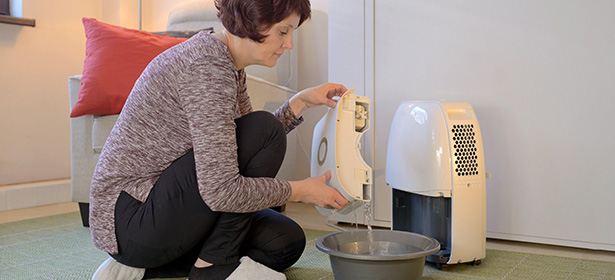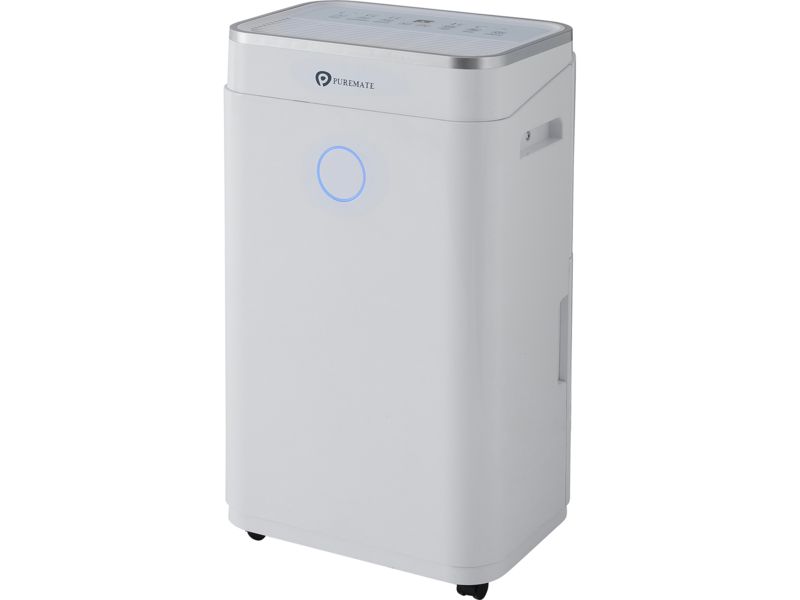How does a dehumidifier work?

Does your home suffer from signs of damp or condensation? Find out whether a dehumidifier will help solve the problem, how they work and how to make the most of yours.
Dehumidifiers are designed to keep a room’s humidity levels in check, so the air is more comfortable and you notice fewer physical signs of damp air, such as mould on walls or condensation on windows.
The best dehumidifiers are easy to use, won't cost you much to run and do a fantastic job of pulling water from the air whether working at room temperature or in colder conditions. The worst, on the other hand, will take much longer to do the same job.
See our guide to choosing the best dehumidifier. Or head straight to our dehumidifier reviews to see all the models we've tested.
How do dehumidifiers work?
Dehumidifiers draw excess moisture from the air, helping to combat condensation, prevent mould growth and reduce damp on walls.
There are two main types of dehumidifier to choose from – refrigerant (also known as compressor) and desiccant. They work in different ways and, as a result, are better suited to different environments.
Refrigerant (or compressor) dehumidifiers
- These draw in air through a filter and over cold coils.
- Water then condenses on the coils and drips into the water tank.
- They're more effective in a heated room than an unheated room, because they need the air in the room to be warmer than the cold surface within the dehumidifier.
- Also, if the room gets too cold, the dehumidifier's coils might start to freeze. The dehumidifier will then go into automatic defrost mode, and will spend time and energy defrosting rather than collecting water.
Desiccant dehumidifiers
- These use an adsorbent material to extract water from the air.
- The material is then heated so that the moisture drips into the water tank.
- Because desiccant dehumidifiers aren't dependent on any particular temperature, they can work more effectively than refrigerants in lower temperatures – the sort of environment you might expect in your typical garage or a conservatory or an unheated basement.
- Desiccant dehumidifiers can use more energy than refrigerant dehumidifiers because of the way they use heat to warm the adsorbent material. They can give out more heat, which you might not necessarily want if your home is already heated.
As a general rule, if you know you'll always be using your dehumidifier in a heated room, go for a refrigerant. If you're going to be using it in an unheated room, or in a range of conditions, go with a desiccant.
That said, a couple of rare refrigerants work OK in colder temperatures, too. These ones won't necessarily work terrifically in warmer temperatures of over, say, 26 degrees. But you might not be too fussed about that, British weather being what it is. How the defrost function has been set up also comes into play here. If a dehumidifier can spend less time defrosting, it can spend more time collecting water.
Check out our best dehumidifiersto find out which ones ace our water extractions tests at both room temperature and in colder temperatures.
When should I use a dehumidifier?
Here are some signs that you need a dehumidifier:
- Your home has been flooded, or you notice water stains and think it might have been flooded before you moved in. First, you'll need to fix the water damage or get a professional to do so.
- The wood in your home is soft to the touch, which means it's rotting. Windowsills are particularly vulnerable.
- Your windows often have condensation on them.
- You notice mould and mildew. Check for little dark spots on your walls and ceilings, and the areas around your toilet and shower.
- Your home has an unpleasant musty smell.
You can use a dehumidifier across the year if the humidity level is high. In summer, for example, you might want to use one if the air inside your house is humid and sticky, and opening a window just seems to let more hot air into your home.
Can a dehumidifier stop damp and mould?
You can use a dehumidifier when you notice signs of damp, such as condensation on your windows. But taking these simple steps could help nip a damp problem in the bud before it gets to the dehumidifier stage.
- Use an extractor fan or open a window when taking a bath or shower.
- Wipe down wet walls and floors in your bathroom after use.
- Seal cracks in your walls with a caulk or sealant.
- Place wet clothes to dry next to an open window. If possible, dry your clothes outside.
- When cooking on a hob, use the extractor fan hood.
If you’re having more persistent problems with damp, these tips might help. If not, you might need to call in a professional.
- Check gutters aren’t clogged and downspouts direct rainwater away from your home.
- Make sure your tumble dryer is properly vented to the outside.
- Check for any leaking pipes or appliances.
- A damp-proofing course might be needed for tackling structural rising damp.
Damp on walls can have many causes – our guide on dealing with damp helps you work out what kind of damp is affecting your property, including advice on dealing with condensation.
Our tips on using your dehumidifier
- Vacuum before using your dehumidifier, so that it doesn't spread dust around the room or clog up the dust filter. This is particularly important if you suffer from allergies.
- You'd probably rather your dehumidifier was tucked out of sight. But you should position it away from walls, furniture and curtains so that air can circulate around it, and it can remove more moisture from the air.
- Keep doors and windows closed when the dehumidifier is running. If windows are open, your dehumidifier will be working harder to try to dehumidify a greater area.
- Empty the water tank after every use, if you can, and definitely before packing it away for storage.
- Use a cloth to wipe down the tank, so that you don't get mould or mildew from water that's been left stagnant.
- Vacuum the air filter on a regular basis to stop it getting blocked; manufacturers tell us that this is a very common reason for dehumidifiers not working properly.
- You can often wash your filter if it's very dirty. But check the manufacturer’s instructions first, as overzealous or inappropriate cleaning might damage your appliance and invalidate any warranty.
- Aim for the room’s humidity level to be between 50% and 60%. If you're buying a dehumidifier for a room containing valuable possessions, though, seek specialist advice as to the humidity level you need.
Also, make sure you buy a dehumidifier that won't break down. Check out our guide to the best and most reliable dehumidifier brands.
How does continuous drainage work?
Dehumidifiers contain a water tank which collects the water that is extracted from the air. You'll need to empty this regularly, ideally daily, to prevent the dehumidifier turning itself off once the tank is full.
Many dehumidifiers can be set up for continuous drainage. This involves attaching a hose (often not provided) to the dehumidifier and running the hose to a floor level drain, if you have access to one.
As this works through gravity, the dehumidifier will need to be raised a bit above the floor.






















